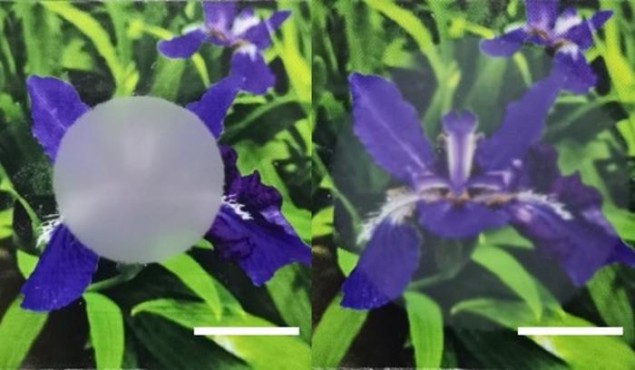Squid-inspired material controls the transmission of light, heat and microwaves
13 Jul 2023
Squid inspired: this flowery scene is overlaid by a disc of the elastomer material. On the left, the compressed material blocks light. On the right, the stretched material lets light through. (Courtesy: ACS Nano/ 10.1021/acsnano.3c01836)
Inspired by the colour-changing skin of squid, researchers in China have designed a material that can switch between being transparent and opaque to radiation at visible, infrared and microwave wavelengths. Led by Zichuan Xu at Nanyang Technological University, the team achieved the result by spraying a silver nanowire film onto a specialized elastomer bilayer.
Squid are well known for their remarkable ability to change the colours and patterns on their skin. In nature, they do this to communicate with each other, and to camouflage themselves from predators and prey.
In some squid species, these changes are controlled by specialized muscles that expand and contract the skin – leaving some parts stretched and taut, and others compressed and wrinkled. This alters the arrangement of specialized cells that reflect and scatter light, and the result is a change in the skin’s overall colour.
In the new study, Xu’s team attempted to mimic this behaviour in the lab by using a “bilayer acrylic dielectric elastomer” material. When stretched flat, the material is generally transparent to visible and infrared light – but when compressed, wrinkles appear that vary the refractive indices of each bilayer.
Mechanical switching
As a result of the wrinkles, incoming visible and infrared waves are reflected and scattered from the elastomer, instead of passing through. In other words, the material can be mechanically switched between transmitting and blocking visible light and radiant heat. However, that initial incarnation of the material was no good at blocking and transmitting microwaves because microwave wavelengths are much longer than infrared light, so microwaves are unaffected by the small wrinkles in the material.
To create a material that also works for microwaves, Xu and team sprayed the elastomer with a thin coating of silver nanowires. As they stretched the material to the point where it began to crack, they saw that microwaves were still able to pass straight through. But as the material was compressed and wrinkled with a strain of –30%, compacting the nanowire network, incoming microwaves were scattered and reflected in a similar way as the visible and infrared waves, which were blocked by the elastomer bilayer beneath.READ MORE

The material’s ability to mechanically switch between transparency and opacity spanned a wide spectral window: covering the entire visible spectrum, infrared wavelengths of up to 15.5 μm, and microwave wavelengths of 24.2–36.6 mm. Its structure was also remarkably resilient: enduring 500 cycles of stretching and compression, while responding to these mechanical changes in under 1 s.
The material now joins a growing list of technologies inspired by the natural world. Xu’s team envisages numerous possible applications in the near future, including innovations in stealth and camouflage technologies. The material could also be used in new types of smart windows that could control both the light and heat passing through them – thereby improving the energy efficiency of buildings.
The elastomer could also have numerous uses in medical devices such as electrocardiographs, which use electrodes placed on the skin to monitor patients’ heart activity. With the nanowire-coated bilayer elastomer, a patients’ electrocardiograph signals could be blocked for everyday use, preventing sensitive medical information from being leaked, then switched to being transparent when their signals need to be monitored by a doctor.
The research is described in ACS Nano.
Sam Jarman is a science writer based in the UK
FROM PHYSICSWORLD.COM 23/7/2023

Δεν υπάρχουν σχόλια:
Δημοσίευση σχολίου